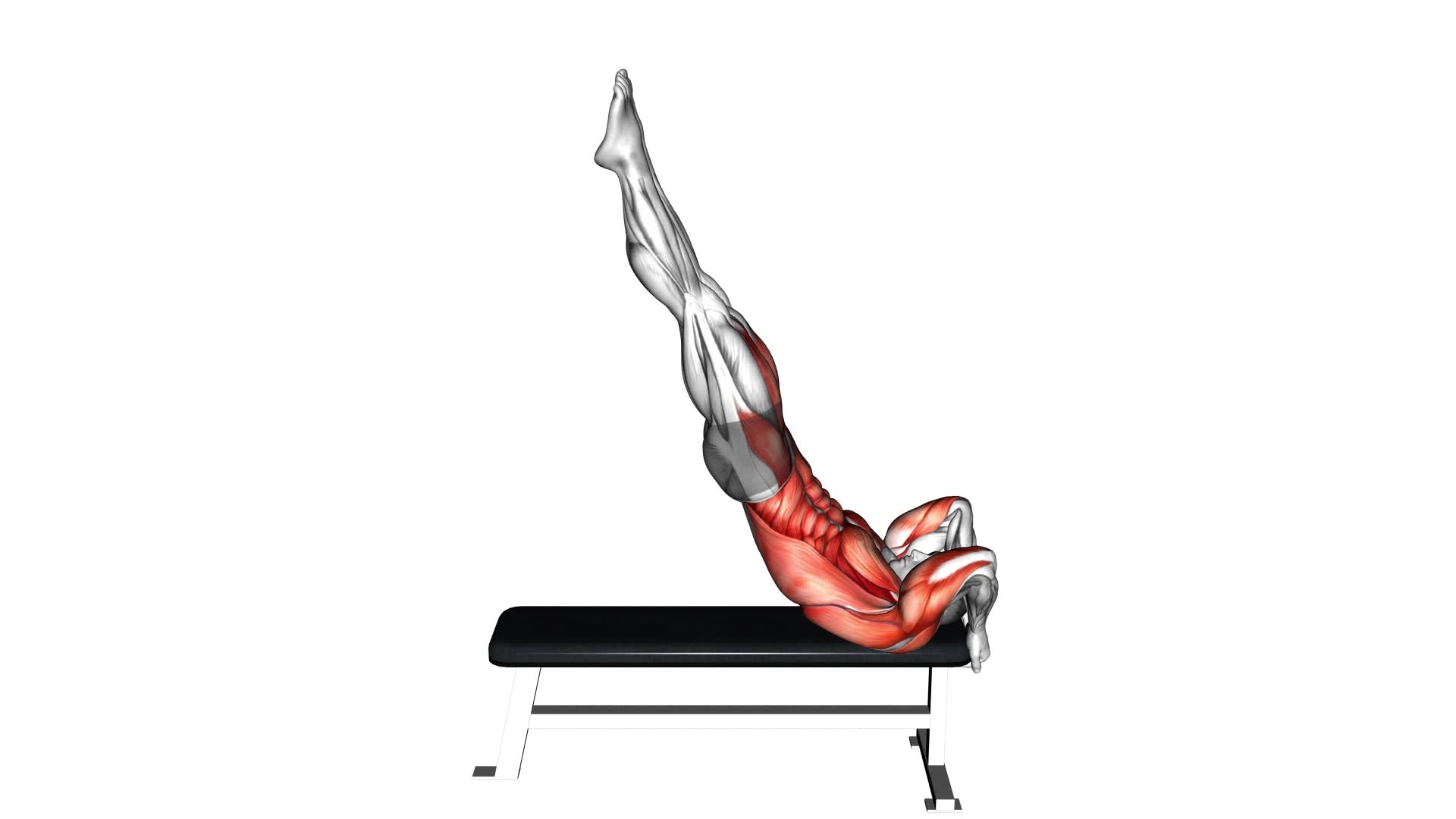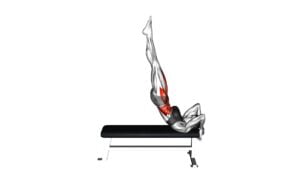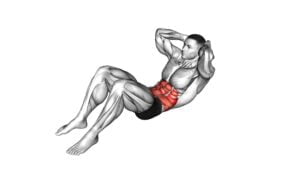Negative Dragon Flag – Video Exercise Guide & Tips

Are you looking for a challenging exercise that targets your core muscles? Look no further than the Negative Dragon Flag!
Watch This Exercise Video
In this video exercise guide, you'll learn the benefits, proper technique, and common mistakes to avoid.
With helpful tips for progressing and increasing difficulty, you'll be well on your way to mastering this intense workout.
Get ready to strengthen your core like never before with the Negative Dragon Flag!
Key Takeaways
- The negative dragon flag targets core muscles and builds strength and stability.
- Proper form and technique are crucial to maximize results and reduce the risk of injury.
- Engaging the core muscles throughout the movement and controlling the descent are important for increased challenge.
- Common mistakes to avoid include not engaging the core properly, using momentum instead of controlled movement, and maintaining improper body alignment.
Benefits of the Negative Dragon Flag
You can experience several benefits from performing the Negative Dragon Flag exercise. This challenging exercise targets your core muscles and helps to build strength and stability. One of the main benefits of the Negative Dragon Flag is its ability to engage your abdominal muscles, including your rectus abdominis, obliques, and transverse abdominis. This exercise also targets your hip flexors, glutes, and lower back muscles, helping to improve overall core strength and stability.
The Negative Dragon Flag requires proper technique and form to maximize its benefits. To perform this exercise, lie on your back with your hands gripping a stable object above your head. Lift your legs and lower back off the ground, keeping your body in a straight line. Slowly lower your legs towards the floor while maintaining control. It's important to engage your core muscles throughout the movement and avoid any swinging or jerking motions.
Equipment and Set-Up for the Exercise
To properly perform the Negative Dragon Flag exercise, you'll need some essential exercise equipment and create an optimal exercise environment.
The equipment needed includes a sturdy horizontal bar or pull-up bar and a mat or padding to support your upper back.
It's important to set up the exercise area in a safe and spacious location, free from any obstacles or distractions.
Essential Exercise Equipment
To properly execute the Negative Dragon Flag exercise, it's essential to have the right equipment and set-up in place. Here are four items of exercise equipment and workout gear that you'll need:
- Pull-up bar: You'll need a sturdy pull-up bar to hang from and provide stability during the exercise.
- Ab mat: An ab mat can provide support to your lower back and make the exercise more comfortable.
- Resistance bands: Adding resistance bands to your dragon flag can increase the challenge and help build strength.
- Gymnastic rings: Rings can be used instead of a pull-up bar, offering a more dynamic and challenging grip.
Having the appropriate exercise equipment and workout gear will enhance your performance and ensure safety during the Negative Dragon Flag exercise. Now that you have the necessary equipment, let's move on to creating an optimal exercise environment.
Optimal Exercise Environment
To create an optimal exercise environment for the Negative Dragon Flag exercise, gather the necessary equipment and set it up properly.
Firstly, ensure that the room temperature is at an optimal level, around 68-72 degrees Fahrenheit, to prevent discomfort during the workout.
Next, arrange a sturdy horizontal bar at a suitable height for performing the exercise. Make sure it's securely fastened to the wall or a sturdy frame to avoid any accidents.
Additionally, consider using a soft mat or padding on the floor to provide cushioning and reduce the risk of injury.
Lastly, plan your workout duration based on your fitness level and goals. Start with shorter durations, around 5-10 minutes, and gradually increase the time as you build strength and endurance. Remember to listen to your body and take breaks when needed.
Proper Technique and Form for the Negative Dragon Flag
Master the proper technique and form for the Negative Dragon Flag to maximize your workout effectiveness and prevent injury.
Here are some key tips to help you perform this exercise correctly:
- Start with proper progression: Before attempting the Negative Dragon Flag, make sure you have mastered the Dragon Flag exercise. This will ensure that your core muscles are strong enough to handle the negative version.
- Maintain a straight body line: Throughout the exercise, keep your body in a straight line from your head to your toes. Avoid any arching or sagging in your back.
- Engage your core muscles: It's important to engage your core muscles throughout the entire movement. This will help stabilize your body and protect your lower back.
- Control the descent: During the negative phase of the exercise, focus on controlling your descent rather than letting gravity take over. This will increase the challenge and effectiveness of the exercise.
Common Mistakes to Avoid
Avoid these common mistakes when performing the Negative Dragon Flag to ensure proper technique and form.
- One common mistake isn't engaging your core properly. To execute the exercise correctly, you need to actively squeeze your abs and lower back muscles, keeping them tight throughout the movement.
- Another mistake to avoid is using momentum instead of controlled movement. Remember, the Negative Dragon Flag is all about slow and controlled lowering. Avoid swinging your legs or using any jerking motions.
- Additionally, it's important to maintain proper body alignment. Make sure your body is in a straight line from head to toe throughout the exercise. Avoid arching your back or letting your hips sag.
- Lastly, don't forget to breathe properly. Many people tend to hold their breath while performing this exercise, which can lead to discomfort and loss of stability. Remember to inhale and exhale throughout the movement to maintain a steady flow of oxygen.
By avoiding these common mistakes and focusing on proper technique, you'll maximize the benefits of the Negative Dragon Flag exercise.
Now, let's move on to some tips for progressing and increasing the difficulty of the Negative Dragon Flag.
Tips for Progressing and Increasing Difficulty
To progress and increase the difficulty of the negative dragon flag exercise, there are a few key points to keep in mind.
Firstly, advanced variations such as adding leg raises or incorporating twisting movements can challenge your core even further.
Secondly, you can increase the difficulty by incorporating resistance, such as using ankle weights or resistance bands, to engage your muscles more intensely.
Lastly, it's important to be aware of common mistakes to avoid, as they can hinder your progress and potentially lead to injury.
Advanced Variations for Progression
To challenge yourself and take your dragon flag exercise to the next level, try incorporating advanced variations for progression. These advanced progressions and techniques will help you continue to build strength and improve your dragon flag performance.
Here are four variations to consider:
- One-Arm Dragon Flag: Perform the dragon flag exercise using only one arm for added difficulty and increased core engagement.
- Weighted Dragon Flag: Hold a weight plate or dumbbell between your feet to add resistance and make the exercise more challenging.
- Extended Dragon Flag: Extend your legs further out past the bench or platform to increase the lever arm and intensify the exercise.
- Dragon Flag with Knee Tuck: Start in a dragon flag position and then tuck your knees towards your chest before extending back out, adding a dynamic element to the exercise.
Incorporating these advanced variations will help you continually progress and push your limits with the dragon flag exercise.
Incorporating Resistance for Challenge
To increase the challenge and continue progressing with the dragon flag exercise, incorporate resistance into your routine.
One effective way to do this is by incorporating bands into your dragon flag exercise. Attach resistance bands to a sturdy anchor point, such as a pull-up bar, and loop them around your feet as you perform the exercise. The bands will add an extra level of difficulty by increasing the resistance as you lower yourself down.
Another option to challenge yourself is by using weighted vests. Start by adding a small amount of weight and gradually increase it over time as you become stronger. This will help to further engage your muscles and enhance the effectiveness of the exercise.
By incorporating bands and using weighted vests, you can take your dragon flag exercise to the next level and continue to push your limits.
Now, let's move on to the next section and discuss some common mistakes to avoid.
Common Mistakes to Avoid
Avoid these common mistakes to effectively progress and increase the difficulty of the dragon flag exercise. To ensure proper form and maximize results, keep the following tips in mind:
- Avoid using momentum: Control is key in the dragon flag exercise. Avoid swinging your body or using momentum to lift yourself up. Instead, focus on engaging your core muscles and using them to lift and lower your body.
- Keep your body straight: It's important to maintain a straight line from your head to your toes throughout the exercise. Avoid arching your back or bending at the hips.
- Don't let your legs drop: One common mistake is allowing your legs to drop too low towards the ground. Keep your legs lifted and parallel to the ground throughout the entire movement.
- Don't rush the exercise: Take your time and perform each rep with control. Rushing through the exercise can lead to poor form and decrease the effectiveness of the movement.
Safety Precautions and Modifications
Ensure your safety and make necessary modifications when performing the Negative Dragon Flag exercise. Safety should always be a top priority when engaging in any form of physical activity. To prevent injuries, it's important to take certain precautions and make modifications if needed.
Firstly, before attempting the Negative Dragon Flag, it's crucial to have a strong core and upper body strength. This exercise puts a significant amount of strain on these areas, so it's important to build a solid foundation before attempting it.
To modify the exercise and reduce the risk of injury, you can start by practicing the Dragon Flag, which is the precursor to the Negative Dragon Flag. This exercise involves keeping your hips on the ground and slowly lowering your legs to the floor, using your core and upper body strength to control the movement. Mastering the Dragon Flag first will help you build the necessary strength and stability for the Negative Dragon Flag.
Additionally, it's important to listen to your body and not push yourself beyond your limits. If you feel any discomfort or pain during the exercise, stop immediately and consult a fitness professional or healthcare provider.
Frequently Asked Questions
How Many Sets and Reps Should I Do for the Negative Dragon Flag?
To maximize your progress with the negative dragon flag, it's important to determine the right amount of sets and reps. Start by focusing on proper form and technique.
Gradually increase the difficulty by adding more sets and reps over time. Aim for 3-4 sets of 8-12 reps to challenge your muscles and stimulate growth.
Remember to listen to your body and avoid common mistakes like using momentum or sacrificing form for quantity.
Can I Do the Negative Dragon Flag if I Have Lower Back Issues?
Yes, you can modify the negative dragon flag if you have lower back issues. It's important to listen to your body and not push yourself too hard.
Start by practicing the exercise with a bent knee position or by using a support, like a bench, to lessen the strain on your lower back.
As for weak core muscles, the negative dragon flag may not be suitable initially. Focus on strengthening your core with other exercises before attempting it.
What Is the Difference Between the Negative Dragon Flag and the Regular Dragon Flag Exercise?
The difference between the negative dragon flag and the regular dragon flag exercise is that the negative dragon flag focuses on the eccentric phase of the movement, where you lower your body down slowly. This variation helps build strength and stability in your core muscles.
The regular dragon flag exercise, on the other hand, involves lifting your body up using your core muscles.
Both exercises have their benefits and can be incorporated into your workout routine for added challenge and variation.
Can I Do the Negative Dragon Flag Without a Spotter?
Yes, you can do the negative dragon flag without a spotter.
The negative dragon flag is a variation of the regular dragon flag exercise that focuses on the eccentric or lowering phase of the movement.
It can be done by slowly lowering your body from the top position to the bottom position.
However, if you're a beginner or unsure about your strength, it's always recommended to have a spotter or try alternative exercises for the dragon flag that don't require a spotter.
How Long Does It Typically Take to Progress From Beginner to Advanced Level in the Negative Dragon Flag Exercise?
To progress from beginner to advanced level in the negative dragon flag exercise, the timeline varies depending on your training intensity. It's important to gradually increase the difficulty and challenge your muscles.
With consistent practice and dedication, you can typically see progress within a few weeks or months. Remember to prioritize proper form and listen to your body to avoid injury.
Push yourself, but also be patient and allow your body to adapt and grow stronger.
Conclusion
In conclusion, the negative dragon flag is an effective exercise that offers various benefits. It strengthens the core and improves overall body control. By following the proper technique and form, avoiding common mistakes, and gradually increasing difficulty, individuals can progress and challenge themselves.
It's important to prioritize safety and make any necessary modifications to ensure a successful and injury-free workout. Incorporating the negative dragon flag into your fitness routine can lead to impressive results.

Author
Years ago, the spark of my life’s passion ignited in my mind the moment I stepped into the local gym for the first time. The inaugural bead of perspiration, the initial endeavor, the very first surge of endorphins, and a sense of pride that washed over me post-workout marked the beginning of my deep-seated interest in strength sports, fitness, and sports nutrition. This very curiosity blossomed rapidly into a profound fascination, propelling me to earn a Master’s degree in Physical Education from the Academy of Physical Education in Krakow, followed by a Sports Manager diploma from the Jagiellonian University. My journey of growth led me to gain more specialized qualifications, such as being a certified personal trainer with a focus on sports dietetics, a lifeguard, and an instructor for wellness and corrective gymnastics. Theoretical knowledge paired seamlessly with practical experience, reinforcing my belief that the transformation of individuals under my guidance was also a reflection of my personal growth. This belief holds true even today. Each day, I strive to push the boundaries and explore new realms. These realms gently elevate me to greater heights. The unique combination of passion for my field and the continuous quest for growth fuels my drive to break new ground.







